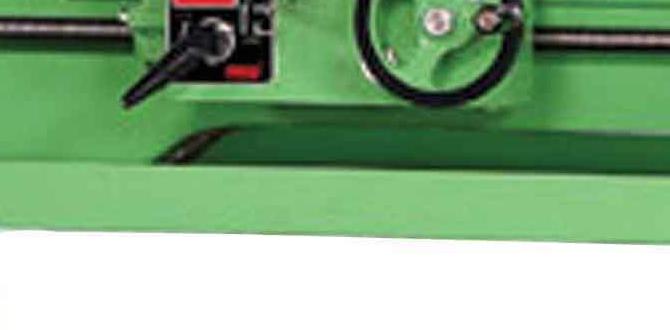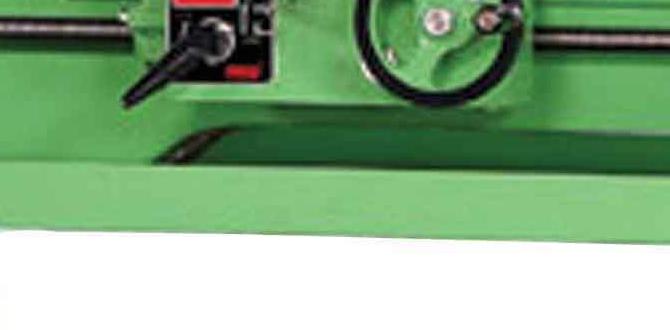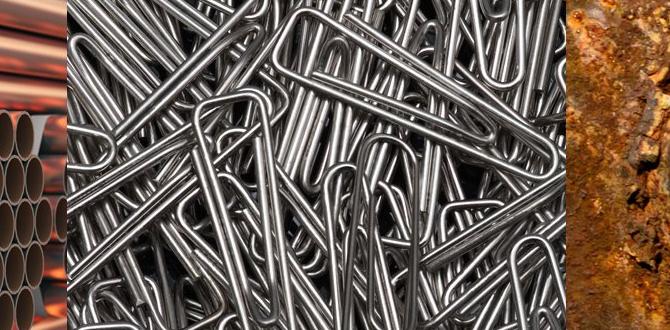Bolded Quick Summary: Premium CNC lathes for production offer superior accuracy, speed, and automation for manufacturing. Choosing the right one involves understanding your material, part complexity, desired output, and budget, while prioritizing reliability and support for efficient, high-volume part creation.
So, you’re looking to ramp up your workshop’s output or perhaps dive into serious production machining? The world of CNC (Computer Numerical Control) lathes can seem a bit overwhelming at first, especially when you’re considering machines built for serious production work. You might be wondering where to even begin with “premium” options. Don’t worry, we’ll break it all down into simple, manageable steps. This guide is designed to help you understand what makes a CNC lathe “premium” for production and how to pick the perfect one for your needs, making a complex decision feel totally achievable.
Understanding Premium CNC Lathes for Production
When we talk about “premium” CNC lathes for production, we’re not just talking about the fanciest paint job or the highest price tag. We’re talking about machines engineered for consistent, high-volume, high-precision manufacturing. These aren’t your hobbyist benchtop models; they are robust, sophisticated tools designed to run reliably for hours on end, producing identical parts with minimal intervention.
Think of them as the precision workhorses of any serious manufacturing operation. They combine advanced control systems, superior construction, and often, specialized features that allow for faster cycle times, tighter tolerances, and greater automation.
Why Invest in Premium for Production?
Investing in a premium CNC lathe for production might seem like a big step, but the benefits can be substantial for your business or advanced workshop:
- Increased Throughput: Premium machines are built for speed. Faster spindle speeds, quicker tool changes, and efficient movement mean you can produce more parts in less time.
- Enhanced Accuracy & Repeatability: For production runs, every part needs to be the same. Premium lathes offer exceptional precision, ensuring that your first part is dimensionally identical to your last, reducing scrap and rework.
- Automation Capabilities: Many high-end machines come with or can be easily integrated with robotic loading systems, bar feeders, and advanced parts unloaders, allowing for lights-out operation.
- Durability & Longevity: Constructed with heavier-duty components and superior materials, these lathes are designed to withstand the rigors of continuous production, leading to a longer service life and less downtime.
- Reduced Operator Dependence: With advanced controls and automation, you can often achieve higher production rates with fewer dedicated operators or by allowing operators to manage multiple machines.
- Versatility for Complex Parts: Premium machines often feature more axes of movement (like C-axis and live tooling) which allows for the creation of more complex geometries in a single setup, saving time and improving accuracy.
These advantages translate directly into a better bottom line, whether that means fulfilling larger orders, taking on more demanding clients, or simply making your operation run more smoothly and profitably.
Key Features of Premium CNC Lathes for Production
What exactly makes a CNC lathe lean towards the “premium” end of the spectrum, especially for production environments? It’s a combination of several critical factors:
Rigid Construction and Heavy-Duty Components
Premium lathes are built like tanks. This means:
- High-Quality Cast Iron Base: A solid, heavy base absorbs vibrations, which is crucial for maintaining accuracy at high speeds.
- Robust Turret/Tool Post: Designed for rapid and precise tool indexing, often with a high number of stations to minimize tool changes.
- Precision Spindle Bearings: High-quality bearings ensure the spindle runs true and remains stable under heavy cutting loads.
- Linear Guideways or Box Ways: These provide smooth, precise movement and excellent rigidity, unlike cheaper bearing systems that can wear out faster under heavy use.
Advanced Control Systems
The control unit is the brain of the CNC lathe. Premium machines feature:
- Intuitive User Interface: Modern, easy-to-navigate touchscreens make programming and operation more efficient.
- High Processing Power: Allows for complex toolpaths and fast G-code execution, leading to shorter cycle times and smoother surface finishes.
- Advanced Features: Look for features like graphical simulation, part program editing, and built-in diagnostics.
- Networking Capabilities: Essential for integration into a larger manufacturing network (MES/ERP systems) for data tracking and remote monitoring.
Spindle Performance
The spindle is where all the cutting happens. For production, you want:
- High Horsepower and Torque: Allows for aggressive material removal rates, especially with harder metals.
- Wide Speed Range: Capable of both high RPMs for small tools and lower RPMs for large diameter cuts.
- Automatic Tool Changer (ATC): For live tooling or automatic turret indexing, drastically reducing setup and cycle times. A fast tool-to-tool time is critical.
- Through-Spindle Coolant: Delivers coolant directly to the cutting edge, improving tool life and chip evacuation.
Automation and Ease of Use
Production means minimizing manual steps:
- Bar Feeder Integration: Seamless compatibility with automatic bar feeders allows for continuous feeding of stock material.
- Parts Catchers & Unloaders: Automatically remove finished parts from the work area, reducing operator intervention.
- Robotic Integration: Many premium machines are designed with robotic loading/unloading capabilities for fully automated cells.
- Easy Setup Features: Tool presetter, auto-probing routines, and intuitive interfaces simplify the setup process between batches.
Material Handling and Chip Management
Long production runs create a lot of chips!
- Efficient Chip Conveyors: Essential for removing large volumes of chips and preventing jams.
- Robust Coolant Systems: High-capacity tanks and powerful pumps to cool the workpiece and tools effectively, and to help wash away chips.
- Enclosed Work Area: Keeps coolant and chips contained, improving shop floor safety and cleanliness.
Assessing Your Production Needs
Before you even start looking at specific machines, you need to really dig into what you need them to do. This is the most crucial step to ensure you get the right premium CNC lathe.
1. What Materials Will You Be Machining?
The type of material significantly impacts the specifications you’ll need.
- Soft Metals (e.g., Aluminum, Brass): Generally easier to machine, requiring less horsepower but benefiting from high speeds for smooth finishes.
- Hard Metals (e.g., Stainless Steel, Titanium, Tool Steels): Require more power, torque, and rigidity. Slower speeds and robust tooling are often necessary.
- Plastics: Can be machined but require specific tooling and cooling strategies to prevent melting.
The machinability of materials can be found in various engineering resources, like the machinability ratings of metals, which can give you a good starting point.
2. What is the Complexity of Your Parts?
Are you making simple shafts or intricate aerospace components?
- Simple Cylindrical Parts: A basic 2-axis turning center (X and Z axes) might suffice.
- Parts Requiring Milling, Drilling on the Face/Periphery: You’ll need a lathe with live tooling capability (driven tools that can mill, drill, or tap while the spindle rotates) and possibly a C-axis for spindle orientation.
- Very Complex Geometries: May require multi-axis lathes (e.g., 4-axis or even 5-axis turning centers) which offer maximum flexibility.
3. What is Your Desired Production Volume?
This is the core of production machining.
- Small Batch Production (e.g., 50-500 parts): A high-quality, precise 2-axis or 3-axis lathe with good automation features might be perfect.
- Medium Batch Production (e.g., 500-5000 parts): Automation features like bar feeders, parts unloaders, and faster tool changers become more important.
- High-Volume Production (e.g., 5000+ parts): You’ll be looking at the most robust machines with the highest levels of automation, potentially even multi-machine setups or fully integrated robotic cells. Consider machines designed for continuous operation.
4. What is Your Budget?
Premium CNC lathes represent a significant investment. Be realistic:
- Initial Purchase Price: This is just the start.
- Installation and Training: Factor in costs for delivery, setup, and operator training.
- Tooling and Fixturing: High-quality tools and custom fixtures for production runs add up.
- Maintenance and Support: Reliable manufacturer support and a good preventative maintenance plan are essential.
Remember, the cheapest machine often costs more in the long run due to downtime, lower accuracy, and reduced efficiency.
5. Required Precision and Tolerances
For production, consistency is key, but some applications demand extremely tight tolerances. Premium machines excel here due to their rigid construction and advanced control systems. Understand the tightest tolerance you typically need to hold.
Types of Premium CNC Lathes for Production
Not all production lathes are the same. They come in various configurations to suit different needs:
1. 2-Axis Turning Centers
The workhorse of many production shops.
- Description: These lathes use two primary axes: X (radial) for diameter and Z (longitudinal) for length.
- Best For: Simple, symmetrical parts like shafts, pins, and bushings. High volume of relatively simple components.
- Production Advantage: Relatively simpler to operate and program, robust for straightforward tasks.
2. Live Tooling / Milling Lathes (Multi-Axis Turning Centers)
These are a significant step up in capability.
- Description: They add driven tools (live tooling) to the turret. This allows the machine to perform milling, drilling, and tapping operations on the workpiece while it’s held in the chuck. Often include a C-axis to orient the spindle.
- Best For: Parts that require features machined off-center, like flats, keyways, or cross-holes. Eliminates the need for secondary milling operations.
- Production Advantage: Reduces part handling and setups, leading to significantly shorter cycle times and improved accuracy for complex parts.
3. Sub Spindle Lathes
For true hands-off production.
- Description: These lathes have a second, driven spindle (the sub-spindle) located at the opposite end of the workpiece from the main spindle. The part can be transferred from the main spindle to the sub-spindle for machining of the back side.
- Best For: Machining both ends of a part in a single setup. Highly efficient for symmetrical parts or parts requiring operations on both ends.
- Production Advantage: Enables complete machining of a part without manual flipping, enabling true “lights-out” manufacturing for many components.
4. Multi-Axis Turning Centers (e.g., 5-Axis)
The ultimate in versatility.
- Description: These combine turning capabilities with advanced milling functions, often incorporating a milling spindle and multiple rotary axes (B-axis for the milling head, etc.).
- Best For: Extremely complex parts, impellers, turbine blades, and components requiring intricate contouring.
- Production Advantage: The pinnacle of single-setup machining, offering maximum flexibility and the ability to create geometries not possible on simpler lathes.
Essential Considerations When Buying
Beyond the core features, several other factors are critical for a production environment:
1. Manufacturer Reputation and Support
You’re investing in a production asset, not just a machine.
- Reliability: Choose manufacturers known for building durable, reliable machines.
- Service Network: Excellent local and responsive technical support, spare parts availability, and trained service technicians are paramount. Downtime is lost money.
- Training: Comprehensive training for operators and maintenance staff is crucial for getting the most out of the machine and ensuring safe operation.
A good starting point for research is to look at what industry leaders are using and what brands are frequently recommended by experienced machinists. Resources like SME (Society of Manufacturing Engineers) often have forums and articles discussing machine tool reliability.
2. Ease of Setup and Tooling
In production, machines spend more time cutting than being set up.
- Fast Tool Changes: Whether it’s a turret or an ATC on a milling spindle, swift and accurate tool changes are vital.
- Tool Presetting: External tool presetting stations or onboard tool measurement systems significantly speed up setup.
- Standardized Tooling: Using common tooling interfaces (e.g., VDI, BMT) can simplify inventory management and fixture design.
3. Chip Management and Coolant Systems
Don’t underestimate this!
- Chip Conveyors: Essential for continuous metal removal. Different types (hinge belt, screw) suit different chip types and volumes.
- Coolant Filtration: High-quality filtration keeps coolant clean, extending fluid life and improving finish.
- High-Pressure Coolant: Through-spindle coolant can be a game-changer for drilling deep holes and evacuating chips from small-diameter tools.
4. Workplace Footprint and Utilities
Consider your shop space.
- Machine Dimensions: Ensure the lathe will fit in your shop with adequate access for maintenance and material loading/unloading.
- Power Requirements: Premium machines can be power-hungry. Verify your shop’s electrical capacity.
- Coolant/Chip Containment: Ensure the machine’s enclosure is effective to manage coolant mist and flying chips, and factor in space for chip bins and conveyors.
5. Software Integration and Data Collection
Modern manufacturing often requires data.
- Industry 4.0 Ready: Can the machine connect to your network for remote monitoring, OEE (Overall Equipment Effectiveness) tracking, and integration with other software systems?
- User-Friendly Programming: Does the control have features like conversational programming, graphical simulation, or easy import of CAD/CAM generated G-code?
Example Comparison: Two Premium Production Lathe Scenarios
Let’s look at how different needs lead to different choices. Imagine two workshops, both aiming for production, but with distinct requirements.
Scenario A: High-Volume Shaft Production
- Task: Produce 10,000 identical steel shafts (30mm diameter, 100mm length) per month with tight diameter and concentricity tolerances.
- Analysis: This is a classic high-volume, simple part scenario. Machining will involve turning, facing, and grooving.
- Ideal Machine Type: A premium 2-axis turning center with a robust turret, high-speed spindle, and excellent rigidity. Crucially, it must integrate seamlessly with an automatic bar feeder and ideally feature an automatic parts catcher and conveyor.
Scenario B: Complex Valve Body Machining
- Task: Produce 500 complex brass valve bodies per month, requiring precise internal bores, O-ring grooves, and multiple drilled/tapped holes on the periphery and face.
- Analysis: These parts require more than simple turning. Secondary milling operations would be costly and time-consuming.
- Ideal Machine Type: A premium multi-axis turning center with live tooling capability. A C-axis for spindle orientation and a sub-spindle for automated part transfer would be highly beneficial to complete both sides in one setup.
Here’s a simplified comparison table:
| Feature | Scenario A (Shafts) | Scenario B (Valve Bodies) |
|---|---|---|
| Core Machining | Turning, Facing, Grooving | Turning, Facing, Boring, Milling, Drilling, Tapping |
| Primary Lathe Type | 2-Axis Turning Center | Live Tool / Multi-Axis Turning Center |
| Key Features Required | Bar Feeder compat., Parts Catcher, High Spindle Speed, Rigidity, Chip Conveyor | Live Tooling, C-Axis, High Torque, Sub |






